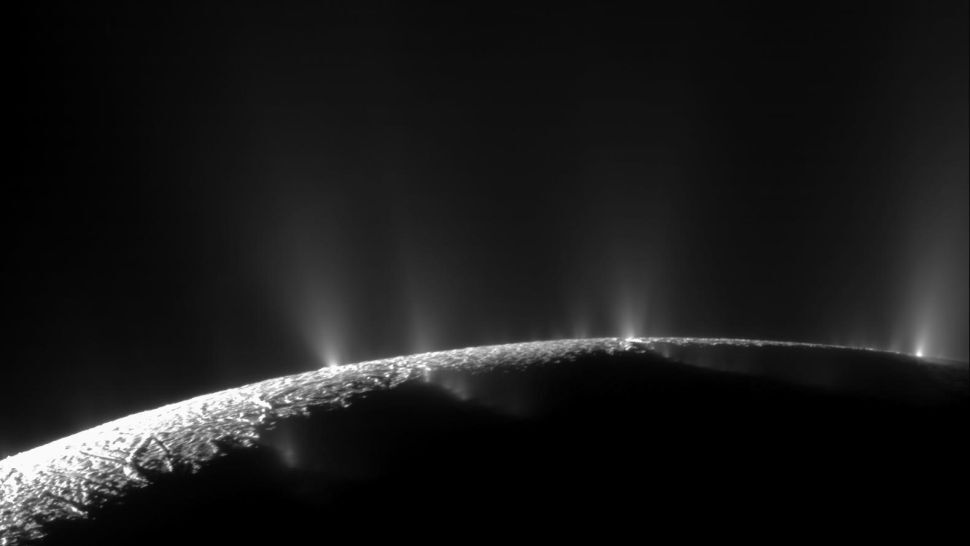28.02.2023
Scientists have apparently solved one of the ocean moon's many mysteries.

Enceladus' geysers blast water vapor, silica particles and other material out into space. (Image credit: NASA/JPL–Caltech/Space Science Institute)
Icy particles of silica ejected from Saturn's moon Enceladus are blasted out by heating at its frozen core as it is squashed and stretched by the gas giant's tremendous gravity.
These particles start their journey at the seafloor of Enceladus' vast subsurface ocean and are rocketed into space, along with huge quantities of water vapor, by geysers within "tiger stripe" features near the moon's south pole. This geyser material eventually goes on to form Saturn's E ring, thus helping to create one of the solar system's most stunning features.
Until now, scientists haven't understood the process that sweeps the silica particles up into the geysers of the sixth-largest of Saturn's 83 known moons. Nor did they know how long this process takes to occur.
A team of researchers led by University of California, Los Angeles (UCLA) planetary science doctoral student Ashley Schoenfeld analyzed data about Enceladus' orbit, its ocean, and its geological features collected by NASA's Cassini spacecraft, which orbited Saturn from 2004 to 2017.
This led them to conclude that as the moon — which possesses an icy shell that is the most reflective surface in the solar system — orbits Saturn, the gas giant's gravitational influence creates tidal forces that squash and squeeze its core. This deformation generates friction that heats the bottom of Enceladus' global ocean, in turn creating strong currents that can carry silica from the ocean floor toward the surface.
"Our research shows that these flows are strong enough to pick up materials from the seafloor and bring them to the ice shell that separates the ocean from the vacuum of space," Schoenfeld said in a statement(opens in new tab). "The tiger-stripe fractures that cut through the ice shell into this subsurface ocean can act as direct conduits for captured materials to be flung into space. Enceladus is giving us free samples of what's hidden deep below."
The model developed by the team helps confirm theories of hydrothermal activity that scientists have been working on ever since Cassini flew through plumes from Enceladus and detected large amounts of hydrogen gas and silica. The spacecraft made its first passage of Saturn's sixth-largest moon in 2005 and its final close approach in 2015.
The findings reached by Schoenfeld and the team also give a viable timeframe over which particles are launched into space, as well as a mechanism that explains why plumes contain silica. It also helps explain how other materials are carried to the icy moon's surface.
"Our model provides further support to the idea that convective turbulence in the ocean efficiently transports vital nutrients from the seafloor to ice shell," study coauthor Emily Hawkins, an assistant professor of physics at Loyola Marymount University, said in the same statement.
The mechanism described by the team resembles activity seen around similar deep-sea hydrothermal vents here on Earth. Here, such vents are home to a wide range of organisms that feed on minerals released by the vents.
NASA is designing several possible missions that would fly past, orbit and even land on Enceladus. These missions could gather data that allows scientists to further investigate the hydrothermal vents of this moon, including potentially searching for signs of life around these geological features.
This new research could help guide these investigations. The study team plans to devise additional models that could also shape future in-situ research around this fascinating snowball moon.
Quelle: SC
